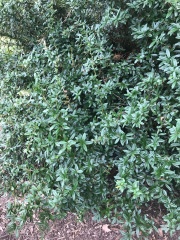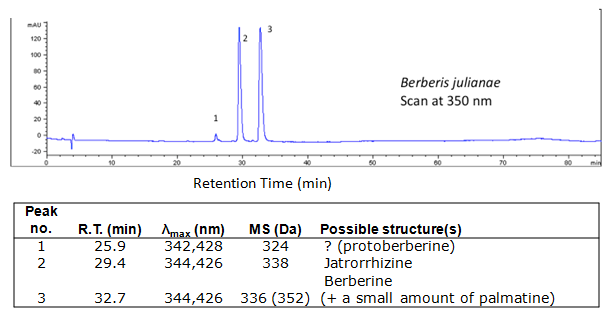Difference between revisions of "Berberis dye (berberis Julianae) LC"
(Created page with "thumb|'''Yellow larkspur/ picture from Denver Botanic Gardens == Description == == Historical importance == = Summary of results = = Analytical in...") |
|||
| (14 intermediate revisions by 2 users not shown) | |||
| Line 1: | Line 1: | ||
| − | [[File: | + | [[File:Berberis jullanae.jpg|thumb|''Berberis julianae'' bush, photo by X. Zhang at the Arnold Arboretum, Boston]] |
== Description == | == Description == | ||
| + | ''Berberis julianae'', also called Mahonia julianae, is a flowering evergreen shrub native to Central China. It is widely grown as an ornamental in other temperate regions. It grows to 6' to 8' tall and 4' to 6' wide. | ||
== Historical importance == | == Historical importance == | ||
| − | = Summary of results = | + | == Summary of results == |
| − | = Analytical instrumentation and procedures = | + | == Analytical instrumentation and procedures == |
| + | HPLC-DAD-MS analysis was performed with an Agilent 1100 liquid chromatography system consisting of an automatic injector, a gradient pump, a HP series 1100 DAD, and an Agilent series 1100 VL on-line atmospheric pressure ionization electrospray ionization mass spectrometer. Separations were done on a Vydac 214TP52 analytical column (2.1 mm diameterX250 mm; 5-ím particle size). The column was eluted at a flow rate of 0.2 mL/min with a tertiary gradient of water (A),acetonitrile (B), and 1% (v/v) aqueous formic acid (C) with the following elution program: 0 min, 90% A, 5% B, 5% C; 0-55 min, a linear gradient to 35% A, 60% B, 5% C; 55-60 min, a linear gradient elution to 15% A, 80% B, 5% C; 60-62 min, isocratic elution at 15% A, 80% B, 5% C; 62-70 min gradient elution to 90% A, 5% B, 5% C; and reequilibration with the latter solvent for 15 min. The mass spectrometer was run both in the negative and positive ion mode. | ||
| − | = Chromatograms = | + | == Chromatograms == |
| − | [[File: | + | [[File:Berbe juli.PNG|center|frame|Absorbance at 350nm (mAU), By X. Zhang]] |
| − | |||
| − | [[File: | + | [[File:Bj1.PNG|center|frame|sample information]] |
| − | = Identified compounds = | + | == Identified compounds == |
| − | [[[SliderGallery rightalign| | + | [[[SliderGallery rightalign|Lar~HPLC-DAD|R~ UV-Vis|is~ UV-Vis]]] |
{| class="wikitable" | {| class="wikitable" | ||
| Line 37: | Line 38: | ||
! scope="col"| Other | ! scope="col"| Other | ||
|- | |- | ||
| − | | | + | | Jatrorrhizine |
| − | | | + | | 29.4 |
| − | | | + | | 337 |
| − | | | + | | 344,426 |
| − | | | + | | |
|- | |- | ||
| − | | | + | | Berberine |
| − | | | + | | 32.7 |
| − | | | + | | 335 |
| − | | | + | | 344,426 |
| − | | | + | | co-elutes with palmatine |
|- | |- | ||
| − | | | + | | Palmatine |
| − | | | + | | 32.7 |
| − | | | + | | 351 |
| − | | | + | | 344,426 |
| − | | | + | | co-elutes with berberin |
|- | |- | ||
| − | |||
| − | |||
| − | |||
| − | |||
| | | | ||
|} | |} | ||
| Line 69: | Line 66: | ||
| − | [[Category:Analysis | + | [[Category:Dye Analysis]] |
| + | [[Category:Reference Materials]] | ||
| + | [[Category:Natural Dyes]] | ||
Latest revision as of 08:20, 29 September 2017
Description
Berberis julianae, also called Mahonia julianae, is a flowering evergreen shrub native to Central China. It is widely grown as an ornamental in other temperate regions. It grows to 6' to 8' tall and 4' to 6' wide.
Historical importance
Summary of results
Analytical instrumentation and procedures
HPLC-DAD-MS analysis was performed with an Agilent 1100 liquid chromatography system consisting of an automatic injector, a gradient pump, a HP series 1100 DAD, and an Agilent series 1100 VL on-line atmospheric pressure ionization electrospray ionization mass spectrometer. Separations were done on a Vydac 214TP52 analytical column (2.1 mm diameterX250 mm; 5-ím particle size). The column was eluted at a flow rate of 0.2 mL/min with a tertiary gradient of water (A),acetonitrile (B), and 1% (v/v) aqueous formic acid (C) with the following elution program: 0 min, 90% A, 5% B, 5% C; 0-55 min, a linear gradient to 35% A, 60% B, 5% C; 55-60 min, a linear gradient elution to 15% A, 80% B, 5% C; 60-62 min, isocratic elution at 15% A, 80% B, 5% C; 62-70 min gradient elution to 90% A, 5% B, 5% C; and reequilibration with the latter solvent for 15 min. The mass spectrometer was run both in the negative and positive ion mode.
Chromatograms
Identified compounds
| Compound | RT (min.) | MW | UV/vis | Other |
|---|---|---|---|---|
| Jatrorrhizine | 29.4 | 337 | 344,426 | |
| Berberine | 32.7 | 335 | 344,426 | co-elutes with palmatine |
| Palmatine | 32.7 | 351 | 344,426 | co-elutes with berberin |
References
[1] [2] [3]


